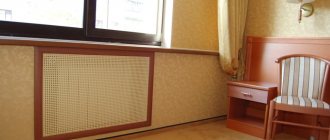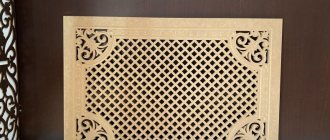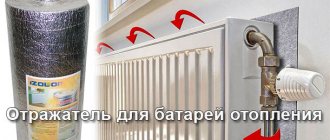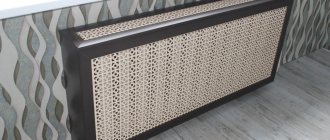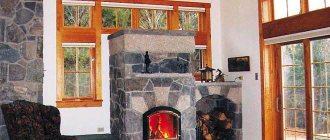Old Soviet heating batteries have a fairly long service life, and even when it runs out, the radiators continue to perform their intended purpose well. The only unpleasant thing is the noticeably damaged appearance, which violates the overall concept of the interior. New radiators have recently undergone some transformations and have acquired an improved appearance, focused on modern trends in the field of interior design. But new heating batteries do not always fit harmoniously into the overall look of the renovation.
Beautiful screen for the radiator
In order to hide the batteries and get rid of flaws in the decor of the living space, a unique and at the same time simple solution was invented in the form of a screen (grid) for the battery. They are made from different materials, different colors and shapes and perform several basic functions.
Brown screen on the radiator
Functional purpose of the screen on the battery
Screens, regardless of their material, are an excellent solution to several problems:
- Protection. Radiators, whether old or new, pose a health hazard to residents. The heated surface of the batteries can cause skin burns, and protruding parts that hit them can cause mechanical damage. In this regard, radiators pose a particular danger to children. Various types of screens for radiators reliably perform protective functions for the health of adults and children.
- Hygienic cleanliness. The complex accordion-shaped batteries have always been a hard-to-reach place where dust and dirt collect. Cleaning near radiators brings a lot of negative emotions, so the screen, protecting the battery from dust particles, will help ease the process.
- Improving the convection qualities of radiators. Thanks to the fact that many screens designed for heating systems have cutouts, additional spaces and specially designed elements, it is possible to increase the overall convection of radiators. Often, a reflective screen is placed between the battery and the wall, and when heated, it increases heat transfer.
- Decorative solutions. Most often, screens for a heating system are installed in order to harmonize it with the interior. To hide the radiator and add missing elements to the decor, grilles are chosen of a non-standard type. Today there are an infinite number of options for making screens for radiators, differing in material, shape, decor and design, so there will be no problems with the choice.
Beige-brown screen for radiator
White screen on the radiator with a pattern
White-brown screen for the radiator in a modern design
Alternative methods
An original option suitable for a modern, neat heating radiator. It consists of arranging a shelf above it and on the side for books, gadgets, and photographs. This approach does not block heat transfer, and the space can be used for various small things.
Do-it-yourself fabric masking of a radiator Source livemaster.ru
Fabric covers are installed on radiators to protect children from sharp corners and hot surfaces. Often mothers sew them themselves, choosing the most original patterns for this.
The battery hidden in a niche can also be covered with fabric. In this case, not a cover, but a stretched fabric can be used. The only condition is that it must match the color of the curtains.
Hiding the battery using a beautiful cat Source livemaster.ru
If you have a cat in your house, you can make a comfortable and warm bed for him. Although the radiator will remain almost completely visible, the original idea and the tailed owner of the bed will divert attention to themselves.
An excellent option (in relation to the interior of the room) would be to wrap the radiator and pipeline with jute thread. This method will fit perfectly into a room designed in Provence or rustic style. The disadvantage of decor is a strong reduction in heat transfer.
Often heating pipes are decorated with flowers, climbing plants or their artificial analogues.
Classification of protective structures
As stated above, there are currently many variations of protective designs for batteries. They may differ in material, installation method and technical design. If we talk about the material from which protective structures are made, the most common screens are:
- metal (the most suitable thermal indicators would be bronze, copper, aluminum and steel)
- wooden (as a rule, these are valuable species)
- glass
- from MDF, HDF
- plastic
White hanging screen for battery
It is customary to use only that material that meets the requirements of GOSTs, otherwise harmful fumes will harm the health of residents.
Brown screen for the battery in the interior
Light beige screen for battery
Plastic grilles for heating radiators
PVC is considered an inexpensive material, which is also often used to create gratings. Its main disadvantage is considered to be instability to mechanical damage. When using PVC, measurements are taken especially clearly; a box located close to the battery will very quickly deform and lose its decorative properties.
During the manufacture of plastic gratings you will need:
- PVC;
- Cutter;
- Drill;
- Set of screws;
- Corners for fastening.
Adhering to the rules stated above, take measurements and cut out the necessary parts from plastic. Using a drill, make holes in the plastic panel. The more holes you make, the better the air will circulate. Connect all structural elements with corners and screws, attach the grille to the wall.
Execution and installation of screens
All screens for radiators are classified according to the method of execution:
- a hinged structure without a cover; it is installed if the radiator is located in a recess under the window.
- a hinged structure with a lid is needed if the battery protrudes.
- flat protections are required if the battery is hidden in a niche.
- A screen-box is installed when it is necessary to hide not only the radiator, but also all related communications.
Dark brown screen for the battery
Protective structures differ not only in the type of design, but also in the method of installation. They often sell ready-made screen boxes that are placed on the heating device. In order to protect small children, such boxes are firmly fixed, preferably to the wall, to prevent contact with the heated element. Typically, wooden protection structures are fixed to the walls and floor, but at the same time they leave access to the battery through opening or removable grilles.
Beautiful brown screen for the battery in the interior of the room
Advantages of types of protective structures Screens made from various materials have pros and cons, knowing which will make it easier to make a choice.
Battery screen in neoclassical style
Features of fastening decorative radiator grilles
Attaching decorative screens, as we have already said, should provide easy and quick access to communications and equipment. In this case, the battery is easier to clean and rinse if necessary. The denser and thicker the box, the less dust and dirt gets inside. Attached and mounted structures are more convenient for emergency “opening”.
Less convenient are those built into the wall. The fact is that such structures are often remote from the radiator itself. In this case, small hidden windows with locking mounts can solve the access problem.
Such structures recessed into the wall can serve as an excellent hiding place for a “stash.”
Metal screens
If the protective structure for heating devices is made of metal, then it has a number of advantages. The main advantage of such screens is their thermal conductivity. Since metal is a good conductor of thermal energy, the convection characteristics of the radiator itself will not be impaired. Such structures have a long service life. The disadvantage of metal screens is the cost, which is an order of magnitude higher than others; it can increase depending on the size and decorative designs. The screens are ideally compatible with aluminum, cast iron, and bimetallic radiators and significantly improve their thermal conductivity characteristics.
White metal screen for battery
Wooden screens
Solid wood is a universal material that can be processed in any way, which allows you to realize even the most incredible ideas and turn a protective screen into an interior item with carved patterns. The environmental friendliness of the selected material is also important, especially for a home with small children. If you choose a screen box made of solid wood, you can forget about changing it for a long time, because such protection is durable and reliable.
Wooden screen for battery
Korchin wooden screen for battery
HDF and MDF screens
A very pleasant advantage of MDF and HDF screens is the price. In addition, the material lends itself very well to processing, which helps realize the most daring interior ideas. Unlike wood, this material is not afraid of cracking. Quite often they make carved, openwork and patterned screens.
White screen for radiator made of MDF
Beige screen for radiator made of MDF
Box installation
After you have chosen the materials and design, you need to install it on the wall.
USEFUL INFORMATION: The heating was on, but the radiators remained cold: what to do
- The drywall should be located 3 cm from the most protruding point of the battery (usually a tap). Find this point and measure the distance from it to the wall. This distance plus 3 cm is the width of the side parts of the box.
- Also measure the distance from the floor to the top point. Determine the width of the front wall of the box.
- After all measurements, prepare the necessary plasterboard parts.
- To assemble them together, you can install supports made of metal guides. They are fixed to the wall and to the floor (this depends on the chosen design).
- Drywall is screwed to the frame with self-tapping screws. A grille is inserted into the front part.
It is best to paint drywall before installation, and the fastening points can be covered with decorative panels.
Glass screens
Good glass battery screens of at least 8 mm are expensive. The most used options are glass flat structures coupled with solid wood. Often they choose from two options: glass screens with a pattern or backlight.
White glass screen for radiator
When choosing a screen for a radiator, you should be guided not only by decorative criteria, but also by functionality. There are quite a few options for boxes, ranging from carved wooden ones to minimalist metal ones. Each type has its own advantages and disadvantages, but they all perform the same role: they protect the coolant from dust and dirt, do not interfere with convection, prevent harm to the health of residents and transform the interior.
Transparent glass screen for radiator
When installing the screen, you should remember that the correct position will determine the proper and high-quality operation of the heating device itself. Therefore, in order to avoid disruption of the convection process, it is worthwhile to provide for the possibility of free air movement. We should not forget about the need for a reflective screen, which will avoid unwanted heat loss.
Screen for the battery in a Scandinavian interior
Battery screen in classic style

